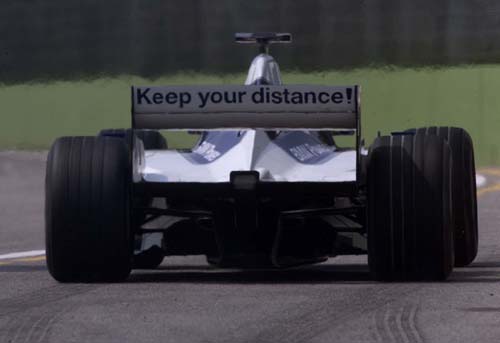Ride Height
''Ride height'' is a term I'm sure most F1 fans have heard at one time or another. It is essentially the distance between the base of
the car and the ground. By adjusting suspension and aerodynamic characteristics
correctly, it is possible to get a very low ride height. Why is this desirable
though?
Why have a low ride height?
''Ride height'' is a term I'm sure most F1 fans have heard at one time or another. It is essentially the distance between the base of
the car and the ground. By adjusting suspension and aerodynamic characteristics
correctly, it is possible to get a very low ride height. Why is this desirable
though?
Why have a low ride height?
Having a low ride height is desirable for a number of reasons.
Obviously, lowering the car in any way lowers the centre of gravity. A
low centre of gravity is important because it helps to make the car pitch
and roll less.
The main reason for a low ride height however, is for aerodynamic reasons.
Lowering the ride height increases a car's downforce without any
significant increase in drag. Cars are normally set up to have the front
ride height of the car (measured at the front axle) lower than the rear
ride height of the car (measured from the rear axle). This relationship
is known as ''rake''. It ensures the undertray of the car produces downforce
and not lift. There is an optimum rake at which cars run though and there
is a point beyond which any extra reduction in ride height may actually
increase drag and promote lift.
Assuming a car's ride height is set up correctly, how does this generate downforce?
Basically, the low clearance of the car causes the air travelling under
the car to speed up (and go faster than the air travelling above the car).
The total pressure at any point in an air stream is the sum of the static
pressure plus the dynamic pressure. The faster moving air under the car
means its total pressure comprises of a larger dynamic pressure component,
resulting in a smaller static pressure component to keep the total pressure
the same. The air travelling over the car however, has less dynamic pressure
and more static pressure. This static pressure difference means there is
an overall downward force on the car - downforce. This principle is much
the same as that which dictates how wings can be used to generate downforce,
only in the case of a wing it is the aerofoil geometry which results in
the pressure difference across the upper and lower surfaces.
Setting ride height
Setting up a car's ride height seems like an easy enough task,
but it certainly isn't. Ride heights are measured while the car is stationary
and they'll invariably change once the car is out on the track doing some
reasonable speed. Downforce, pitch, roll, suspension stiffness and other
factors will cause the real distance between the bottom of the car and
the ground to change from the measured ride height.
One way to make sure the ''moving ride height'' remains close to the
stationary, measured ride height, is to run extremely stiff suspension.
This is not always desirable as the car will often be too nimble for the
drivers and tyre wear will be high.
Running softer suspension is not really the answer either, as if the
suspension is too soft and the ride height is too low, the car is going
to ''bottom out''. Not only will this slow the car down, but in F1 care has
to be taken to ensure the cars don't bottom out so much that they wear
the ''plank'' underneath the car past the legal limit.
A compromise between stiff and soft suspension has to be made. Fortunately,
modern cars don't have to be compromised too much if fitted with what's
known as a ''third spring''.
The 3rd spring
By using a 3rd spring, it is possible to achieve stiffer suspension whilst
the car's tyres are being displaced by the same amount (eg. travelling
down a straight), yet at the same time it is possible to still reap the
benefits from a softer suspension setup whilest cornering (bump or rolling
motion). The trick is in the ''T-bar'' linking the springs/dampers to each
other and to the bellcranks.
When both tyres are displaced by the same amount (as they would through
aerodynamic forces pushing the car down on the straight), all 3 springs/dampers
work together, as the T-bar does not rotate about any of it's pivots, providing
a very stiff system.
When only one tyre is displaced, the T-bar rotates about it's central
pivot, resulting in only the spring/damper that corresponds to that wheel
being worked. (note: the rotation of the T-bar will cause the other side
of the suspension to be ''extended'' however). The diagram below explains
this better.
Glossary:
Roll - The angle between the car's body and a longitudinal
axis. Roll is caused by centrifugal forces and ''uneven'' track surfaces.
Pitch - The angle between the car's body and a transverse axis.
Pitch is caused by the car's accelleration or decelleration. It is most
noticeable under heavy braking, with the car tending to angle forward.
The diagram shows a car pitching due to acceleration (exaggerated).

